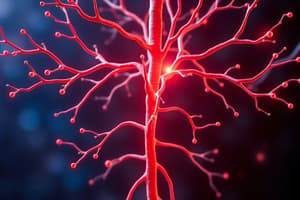Podcast
Questions and Answers
Which branch of the autonomic nervous system is responsible for 'fight or flight' responses?
Which branch of the autonomic nervous system is responsible for 'fight or flight' responses?
- Central Nervous System
- Parasympathetic Nervous System
- Sympathetic Nervous System (correct)
- Enteric Nervous System
What is the primary neurotransmitter for the parasympathetic nervous system?
What is the primary neurotransmitter for the parasympathetic nervous system?
- Norepinephrine
- Serotonin
- Acetylcholine (correct)
- Epinephrine
Which drug class mimics sympathetic nervous system activation?
Which drug class mimics sympathetic nervous system activation?
- Adrenergic Antagonists
- Adrenergic Agonists (correct)
- Cholinergic Antagonists
- Cholinergic Agonists
What is a common use of cholinergic agonists?
What is a common use of cholinergic agonists?
Which drug class is used to block the effects of acetylcholine?
Which drug class is used to block the effects of acetylcholine?
What is a potential side effect of adrenergic drugs?
What is a potential side effect of adrenergic drugs?
Which administration route is preferred for rapid onset during emergencies?
Which administration route is preferred for rapid onset during emergencies?
Which agent is an example of a beta-blocker?
Which agent is an example of a beta-blocker?
What is one of the uses of adrenergic antagonists?
What is one of the uses of adrenergic antagonists?
What does SLUDGE stand for in relation to cholinergic drug side effects?
What does SLUDGE stand for in relation to cholinergic drug side effects?
Flashcards are hidden until you start studying
Study Notes
Overview of the Autonomic Nervous System (ANS)
- Divided into two main branches:
- Sympathetic Nervous System (SNS): Prepares the body for 'fight or flight' responses.
- Parasympathetic Nervous System (PNS): Responsible for 'rest and digest' functions.
Key Neurotransmitters
- Acetylcholine (ACh): Primary neurotransmitter for the PNS; acts on muscarinic and nicotinic receptors.
- Norepinephrine (NE): Main neurotransmitter for the SNS; acts on adrenergic receptors (alpha and beta).
Pharmacological Agents
-
Adrenergic Agonists
- Mimic SNS activation.
- Examples: Epinephrine, norepinephrine, dobutamine.
- Uses: Treat anaphylaxis, cardiac arrest, hypotension.
-
Adrenergic Antagonists
- Block effects of adrenergic neurotransmitters.
- Examples: Propranolol (beta-blocker), phenoxybenzamine (alpha-blocker).
- Uses: Manage hypertension, tachyarrhythmias, certain tumors.
-
Cholinergic Agonists
- Mimic PNS activation.
- Examples: Bethanechol, pilocarpine.
- Uses: Treat urinary retention, glaucoma.
-
Cholinergic Antagonists
- Block effects of acetylcholine.
- Examples: Atropine, scopolamine.
- Uses: Pre-anesthetic agent, treat bradycardia, motion sickness.
Drug Administration Routes
- Oral: Common for chronic conditions; variable absorption.
- Intravenous: Rapid onset; used in emergencies.
- Subcutaneous/Intramuscular: Slower absorption; suitable for vaccines.
- Topical: Direct application for local effects.
Side Effects and Considerations
- Adrenergic drugs may cause increased heart rate, hypertension, anxiety.
- Cholinergic drugs may lead to salivation, lacrimation, urination, diarrhea, gastrointestinal distress, emesis (SLUDGE).
- Monitor for adverse reactions and interactions with other medications.
Veterinary Applications
- Anesthesia: Use of agents to modify autonomic responses during surgery.
- Management of heart conditions: Use of beta-blockers and other cardiovascular drugs.
- Control of gastrointestinal motility: Application of cholinergic agents.
Conclusion
Understanding the pharmacology of the autonomic nervous system in veterinary medicine is crucial for effective treatment strategies and patient care. The appropriate use of agonists and antagonists can greatly influence the physiological responses in animals.
Overview of the Autonomic Nervous System (ANS)
- ANS has two primary divisions: the Sympathetic Nervous System (SNS) for 'fight or flight' and the Parasympathetic Nervous System (PNS) for 'rest and digest'.
Key Neurotransmitters
- Acetylcholine (ACh):
- Major neurotransmitter in PNS.
- Acts on muscarinic and nicotinic receptors.
- Norepinephrine (NE):
- Dominant neurotransmitter in SNS.
- Functions through adrenergic receptors (alpha and beta).
Pharmacological Agents
-
Adrenergic Agonists:
- Stimulate SNS responses.
- Notable examples: Epinephrine, norepinephrine, dobutamine.
- Common uses include treatment for anaphylaxis, cardiac arrest, and hypotension.
-
Adrenergic Antagonists:
- Inhibit adrenergic neurotransmitter effects.
- Examples include propranolol (beta-blocker) and phenoxybenzamine (alpha-blocker).
- Utilized for hypertension management, tachyarrhythmias, and certain tumors.
-
Cholinergic Agonists:
- Activate PNS responses.
- Key examples: Bethanechol and pilocarpine.
- Applications include addressing urinary retention and glaucoma.
-
Cholinergic Antagonists:
- Block acetylcholine effects.
- Examples: Atropine and scopolamine.
- Function as pre-anesthetic agents and for treating bradycardia and motion sickness.
Drug Administration Routes
-
Oral:
- Common route for chronic conditions; absorption can vary.
-
Intravenous:
- Allows rapid therapeutic effects; typically used in emergencies.
-
Subcutaneous/Intramuscular:
- Provides slower absorption; commonly employed for vaccines.
-
Topical:
- Direct application yields localized effects.
Side Effects and Considerations
- Adrenergic drugs may induce side effects like increased heart rate, hypertension, and anxiety.
- Cholinergic drugs can cause SLUDGE symptoms: salivation, lacrimation, urination, diarrhea, gastrointestinal distress, and vomiting.
- Continuous monitoring is essential for adverse reactions and drug interactions.
Veterinary Applications
-
Anesthesia:
- Utilizes drugs to modulate autonomic responses during surgical procedures.
-
Management of Heart Conditions:
- Involves the use of beta-blockers and cardiovascular medications.
-
Control of Gastrointestinal Motility:
- Cholinergic agents are applied for this purpose.
Conclusion
- A strong grasp of ANS pharmacology is vital in veterinary medicine for effective treatment and patient outcomes.
- Proper utilization of agonists and antagonists significantly impacts physiological responses in animals.
Studying That Suits You
Use AI to generate personalized quizzes and flashcards to suit your learning preferences.




